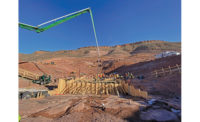The billion-dollar price tag to redevelop Denver’s National Western Center Campus is anticipated to return 10 times its cost to the local economy. Infrastructure work at the site is well underway, with plans for additional construction boosted by an upcoming release of $175.8 million in city bonds.
The NWC project is an ambitious effort to convert the 94 acres in north Denver that host the annual National Western Stock Show into a 250-acre development to be used throughout the year. The campus will become a “year-round destination, strategically aligning education, economic development and tourism and entertainment,” according to the 2012 agreement signed between the major partners. Those include the city and county of Denver, Colorado State University, the Denver Museum of Nature and Science, History Colorado and the National Western Stock Show Association.
The Mayor’s Office of the National Western Center (NWCO) is managing the build-out based on the project’s 2015 master plan. The $1-billion-plus price tag includes Phases 1 and 2 of the master plan as well as the cost of CSU’s Spur campus and the planned 110,000-sq-ft WSSA Legacy Building.
The project’s success hinges on the collective early visioning efforts and the master plan. “We asked, ‘How do we, as five institutions, each with our own roles and own vision, ensure that this collective effort becomes greater than the sum of our respective parts and missions?’” says Jocelyn Hittle, CSU’s assistant vice chancellor for Spur campus and special projects.
Other complexities include the project’s location in the heart of the city’s Globeville, Elyria and Swansea neighborhoods as well as the need to coordinate with other entities, such as Metro Wastewater Reclamation District, Xcel Energy, the Regional Transportation District and Denver Rock Island Railroad.
“We really want to be operating at the nexus of food, water and health...”
—Jocelyn Hittle, Assistant Vice Chancellor for Spur Campus and Special Projects, CSU
A series of complex agreements outlines what each entity expects. That’s why it’s imperative to manage those expectations and react quickly to change, says Tykus Holloway, NWCO executive director. “We have a governance body and governance document that shares our agreements together that we’ve all signed,” he says. “Having a process and group in place that can oversee those changes and be nimble and react to them was really key.”
One of the group’s first major tasks was to reconnect the NWC campus to the surrounding neighborhoods and improve access to the South Platte River, which runs along the western border of the site.
“Several barriers existed on campus, both natural and man-made,” Holloway says. “The river itself is a barrier to mobility for getting across to the campus.”
Also, the original rail lines running through the site, used for transporting animals and people to the stock show in its early years, had become a major impediment to connectivity.
“There’s a lot of similarities to Denver Union Station,” says Brad Buchanan, CEO of the National Western Authority. “You’ve got this mixed-use, transit-oriented development with a [RTD] rail station right on campus. We have riverfront on the edge of the campus; we have historic buildings and a consolidated rail line.”
District Energy System
Another of the team’s challenges was the need to upgrade infrastructure at the site, which includes relocating major sewer lines blocking access to the South Platte River. The lines are part of a 1,900-ft-long segment of two 6-ft-dia, above-grade pipes known as the Delgany Interceptor. Owned by the Metro Wastewater Reclamation District (MWRD), the pipes convey wastewater from nearly all of Denver’s neighborhoods to a treatment plant a mile north of the NWC campus.
When NWCO officials began investigating how the pipes might be relocated and buried, they were alerted to MWRD’s own challenge with the interceptor, which was the need to reduce the effluent’s temperature, which ranges from 17° to 22° C, so as not to disrupt the biology of the South Platte and meet federal Clean Water Act regulations.
“One of the nine guiding principles included in the 2015 master plan is to ‘embrace an ethic of regeneration,’” says Barb Frommell, an urban planner hired by NWCO as director of strategic partnerships. Frommell says the group saw an opportunity in MWRD’s study of wastewater heat-transfer systems. “They could help us get rid of these pipes that were standing in the way of the South Platte River and perhaps we could help them with their temperature issue,” she adds.
NWCO and MWRD researched how to implement a wastewater heat-transfer system, working with program manager Jacobs Engineering, Xcel Energy and the National Renewable Energy Laboratory. They solicited advice from officials in Vancouver, B.C., where wastewater heat-transfer systems are already in use. A subsequent 2017 study by AECOM provided “validation that not only was this an intriguing opportunity, but that this was the best opportunity for wastewater heat recovery that they had ever encountered,” Frommell says.
“There’s a lot of similarities to Denver Union Station.”
—Brad Buchanan, CEO, National Western Authority
The team chose to install a district energy system, a complex network of underground hot and cold water pipes that allow for sharing of energy among the buildings. Even though a district energy system is usually more expensive to implement, cost analyses concluded it was comparable with traditional energy approaches because upfront capital costs would be offset by operations and maintenance savings.
Frommell says the team next sought an energy partner to design, construct and operate the system, drawing responses from seven proposing teams, with the eventual selection of EAS Energy Partners, comprised of Enwave, AECOM and Colorado-based Saunders Construction.
Dan Kelly, senior vice president at Enwave, says comparable systems are already up and operational, citing one in Vancouver and a comparable 1-MW system in Scotland. The NWC district energy system will be about 4 MW, according to Jeff Giffin, project engineer at Enwave, making it the largest sewer-heat recovery district energy system of its kind in North America.
“This type of technology is one of the big opportunities and growth areas for district energy and renewable heating and cooling because there are these types of large sewer pipes in every city,” Giffin says.
Kelly says district energy systems are found widely on campuses and military bases and “use robust equipment that’s been proven. The difference [at NWC] is how we’re using the sewer as a heat sink,” he says.
The sewer is the baseload heating and cooling system for the entire campus, with data showing a constant flow through the interceptor that ranges from 9,000 gallons to 26,000 gallons per minute.
“Our connection is designed to take about 3,000 gallons per minute out,” says Giffin. “So, in the worst-case scenario, at the lowest load, [about 5:00 a.m.], we’ll only be using a third of that wastewater flow.”
The system includes a central utility plant for redundancy, which can provide 100% of the heating and cooling in case of an interruption. However, Giffin says, “if the wastewater flow in the sewer stops, the city’s likely got bigger problems to deal with.”
Holloway says another added benefit of the district energy system is that the campus can become an area of refuge for both people and animals in case of emergencies such as the wildfires that raged across the West last summer. Design for the district energy system is complete, with $31-million worth of construction underway. The system is expected to be complete this time next year. The district energy solution is estimated to reduce greenhouse gas emissions by 2,600 metric tons of carbon (CO2) per year.
Horizontal Work
Brian Penner, operations manager for Hensel Phelps, the construction manager selected to manage a $275-million horizontal integrated construction (HIC) contract for NWCO, says sequencing the work is among the project’s biggest challenges. “It was really important to create packages in a very efficient manner,” Penner says.
Hensel Phelps contracted with several horizontal contractors, including Ames, Flatiron and Iron Woman, to build out the campus infrastructure, which includes realignment of the rail lines; roadway reconstruction and realignment of pad-ready sites for vertical construction; a central utility spine running underneath the main plaza; and construction of a new 51st Avenue Bridge.
Holloway says it made sense to have the HIC contractor use EAS Energy Partners’ specifications to build some of the base trunk infrastructure. Penner says the ability to perform wet well tie-ins and support for EAS’s equipment “maximizes safety and is also a win-win for efficiency.”
An intergovernmental agreement with the Colorado Dept. of Transportation, which is concurrently building out the Central 70 freeway expansion just south of the NWC site, provided additional savings. CDOT was able to offer 200,000 cu yd of clean fill excavated from Central 70 to the NWC site, saving fill and trucking costs for both entities.
In February, the HIC team completed realignment of nearly three miles of rail lines. “The rail was one of the centerpieces we settled on with the master plan,” says Holloway. The realignment eliminates a major barrier to the riverfront, improves overall site safety and enables realignment of the new Bettie Cram and National Western drives to create a central entrance at the spot where CSU is under construction on its Spur campus.
Spur Coming to Life
CSU says its presence on the NWC campus, in the form of three buildings known as the Spur, is an opportunity to expand its reach. “We really want to be operating at the nexus of food, water and health, rather than thinking about those challenges separately,” Hittle says.
JE Dunn, working with CAA ICON, CSU’s owner’s representative at Spur, has started building the 114,000-sq-ft Vida, 60,000-sq-ft Terra and 122,000-sq-ft Hydro buildings, each named for its specialty.
Vida is designed to support animal health and includes a clinic operated by the Denver animal shelter Dumb Friends League. Terra is home to food science studies and includes greenhouses and a green roof. Hydro will support the study of water issues and includes a new water-quality lab run by Denver Water.
The Vida building, along with Terra, is scheduled to be complete and open in time for the 2022 Stock Show in January. Hydro is slated to open later that fall.
Hittle says commonalities among the Spur buildings are transparency and a public-facing component that “opens up the science to everyone.” Many of the spaces include glass walls and low-voltage systems to support real-time interaction. Once complete, CSU’s Spur facilities will host conferences and meetings and house researchers and college students pursuing degrees in agricultural fields and local artists working in studios at the site. The buildings will be open to the public, including school groups, for tours and events.
Dimensional Innovations was hired to design educational exhibits for all three buildings, providing a “continuity of experience for kids and families as they move throughout,” Hittle says.
Future Plans
NWCO recently announced that it has abandoned a proposed public-private partnership for the 60 acres in the southeast portion of the site known as the Triangle, but in March the Denver City Council approved issuing bonds that will provide $175.8 million for continued construction of Phases 1 and 2, with a sale date scheduled for April 6. Future phases, which includes the Triangle parcel, are not included in the $1-billion budget and remain unfunded.
NWCO had solicited a proposal for a P3 partner that would have helped build a new exhibition hall, replace the aging Denver Coliseum with a new 10,000-seat arena and restore a historic 1909 building in exchange for the right to develop 42 acres in the southeast part of the NWC campus.
Holloway says the entire partnership will regroup to explore its future options.
“One of the key themes that came through during conversations with the community was around affordable housing and jobs and open space,” he says. “We’re thinking there could be an opportunity to build some of these additional assets or have some of the proceeds from redevelopment help support those. Nothing’s off the table.”












Post a comment to this article
Report Abusive Comment